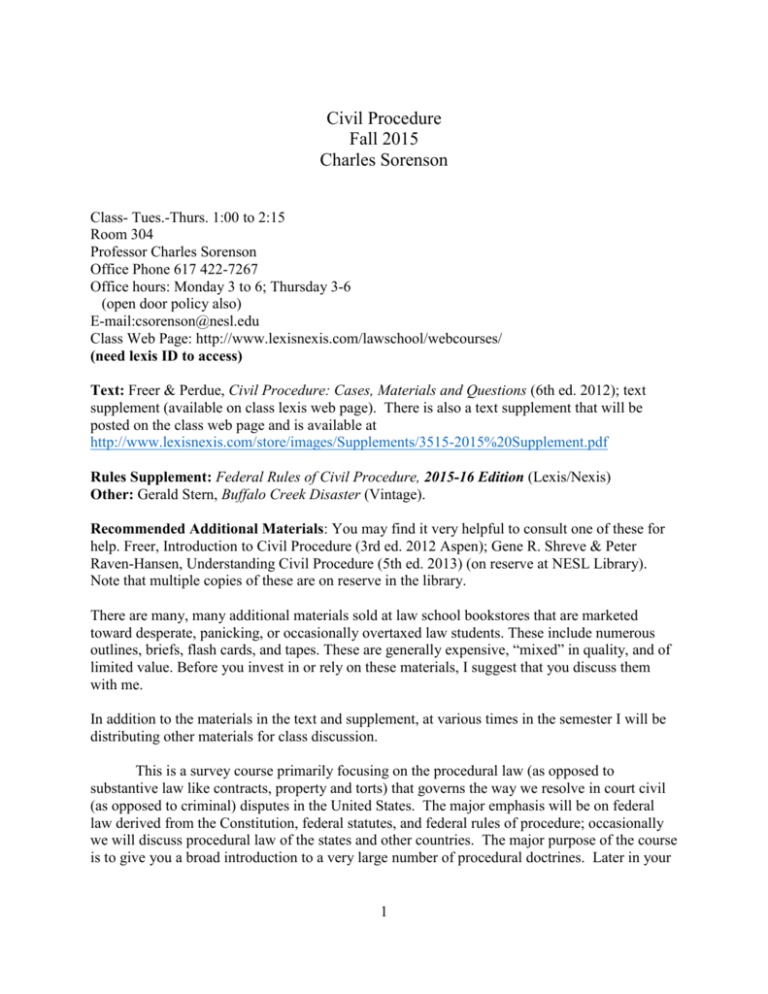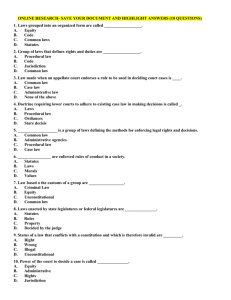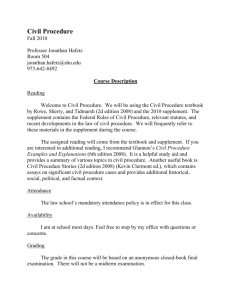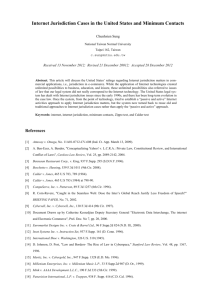Syllabus
advertisement

Civil Procedure Fall 2015 Charles Sorenson Class- Tues.-Thurs. 1:00 to 2:15 Room 304 Professor Charles Sorenson Office Phone 617 422-7267 Office hours: Monday 3 to 6; Thursday 3-6 (open door policy also) E-mail:csorenson@nesl.edu Class Web Page: http://www.lexisnexis.com/lawschool/webcourses/ (need lexis ID to access) Text: Freer & Perdue, Civil Procedure: Cases, Materials and Questions (6th ed. 2012); text supplement (available on class lexis web page). There is also a text supplement that will be posted on the class web page and is available at http://www.lexisnexis.com/store/images/Supplements/3515-2015%20Supplement.pdf Rules Supplement: Federal Rules of Civil Procedure, 2015-16 Edition (Lexis/Nexis) Other: Gerald Stern, Buffalo Creek Disaster (Vintage). Recommended Additional Materials: You may find it very helpful to consult one of these for help. Freer, Introduction to Civil Procedure (3rd ed. 2012 Aspen); Gene R. Shreve & Peter Raven-Hansen, Understanding Civil Procedure (5th ed. 2013) (on reserve at NESL Library). Note that multiple copies of these are on reserve in the library. There are many, many additional materials sold at law school bookstores that are marketed toward desperate, panicking, or occasionally overtaxed law students. These include numerous outlines, briefs, flash cards, and tapes. These are generally expensive, “mixed” in quality, and of limited value. Before you invest in or rely on these materials, I suggest that you discuss them with me. In addition to the materials in the text and supplement, at various times in the semester I will be distributing other materials for class discussion. This is a survey course primarily focusing on the procedural law (as opposed to substantive law like contracts, property and torts) that governs the way we resolve in court civil (as opposed to criminal) disputes in the United States. The major emphasis will be on federal law derived from the Constitution, federal statutes, and federal rules of procedure; occasionally we will discuss procedural law of the states and other countries. The major purpose of the course is to give you a broad introduction to a very large number of procedural doctrines. Later in your 1 law school careers you will focus more narrowly on specific procedural law especially relevant to litigation skills. Civil Procedure is one of the most challenging courses in law school; it will also be one of the most useful throughout your legal career. As you embark upon your study, keep the following guidepost in mind: The purpose of our procedural system is the efficient, timely and just resolution of civil controversies. Cf. Fed. R. Civ. P. 1. Students find many of the doctrines covered in the Civil Procedure course to be quite difficult, and find that merely studying the assigned text materials (as well as studious attention to class discussions) is not enough. When you have questions or concerns about the course, I urge you to come and see me to discuss them, either individually or in groups. You may also contact me by e-mail. Given our cyber-oriented society, I also have also established a Civil Procedure discussion bulletin board this semester, as part of the Civil Procedure course Web page that will have supplemental course materials. The primary purpose of the discussion board is to provide a forum for raising and very briefly discussing common questions and issues. I will also use the discussion board and the Web page to post study questions and, provide supplemental information and make announcements. The discussion board may be particularly useful for some people who lack the time (or desire) to discuss questions with me personally. Attached is a syllabus of the topics we will be covering this semester. As you can see, we will generally proceed through the first portion of the text in its paginated order. As a rule you should read the major case excerpts in the text very carefully: you will be expected to be as familiar with the material as if you were an attorney litigating the case, and you may be called upon to discuss the cases in detail in class. Introductory and narrative material should be read carefully for background and class discussion purposes, but you usually will not be called upon to discuss this material involuntarily. Questions following the cases and materials should be read and considered for the light (and, at times, the darkness) they shed on the principles involved in the cases and possible issues for class discussion. When the text refers you to a particular statute or rule of civil procedure, or if a particular numbered procedural statute or rule is alluded to in an assigned case or notes, be sure to look at the rule or statute. The relevant statutes and rules are generally set out in the federal rules supplement, which should be brought to every class. 2 “Buffalo Creek” One of the most difficult aspects of studying Civil Procedure in the first year of law school for most students is that students lack sufficient experience or context for understanding and applying the many seemingly technical rules and doctrines we study. "Buffalo Creek" presents such a context for many of the issues and doctrines we will study this fall. In essence, this account of a real case highlights the human drama, policies, politics, moral or ethical issues, financial considerations, and practical problems that are involved in almost every civil case to some extent. “Buffalo Creek” is required reading for the fall semester since it deals with many of the doctrines we will be studying this semester. It is critical that you remember that "Buffalo Creek" is simply a more extended presentation of the kinds of stories and issues that are present in each of the textbook cases you read this semester. The court opinions in the text simply present the surface arguments and outcomes as to particular legal issues that arise. As you read these opinions in the text think about the underlying "stories"-- that is-- the human drama, policies, strategies, politics, ethics, financial and practical issues involved. As you read "Buffalo Creek" you should pay particular attention to the "procedural" issues or aspects of the stories and how they relate to the ultimate goals and outcomes. For example, as you read try to identify why the case was filed in the court that it was and what legal requirements must be met for it to be brought there. Generally, references to passages that are particularly relevant to cases, doctrines or issues we are studying will be noted on the class syllabus or on the Web page. Students are also encouraged to raise questions they have about the book and procedural issues on the discussion board, in class, or with me outside of class. We will generally not, however, spend substantial class time discussing the book, but will focus on the text cases. Exams and Grading. Issues from all of the above categories of materials may appear on the written examinations. There will be a mid semester quiz and a term examination which will contain traditional law school exam questions asking you to analyze a fact situation under the law of procedure. The exam will also contain objective questions (e.g., multiple choice) more directly seeking indications of your knowledge. Approximately two-thirds of the issues or points on exams will be drawn directly from class discussions. There will also be occasional written problems and exercises that will be graded on a pass/fail basis. Performance on these will be factored into the final grade for the semester. Class attendance and punctuality are required. Repeated absences (20 % of classes) will result in a grade of “F” in the course. Class participation is also required and can affect your grade in the course. Superior class participation can raise your grade by up to .25 points; ineffective participation can have the opposite effect. Failure to participate can have a more serious negative impact. Participation generally takes three forms: (1) every 3 student will be called upon several times during the year to present cases, analyze issues, or answer specific questions; (2) students are also expected voluntarily to answer questions, raise issues or otherwise contribute to class discussions or web page discussions; and (3) students are required to complete assigned class problems and exercises. Topics First Semester As a rule, after the introductory period, we will be covering approximately 10 to 15 pages in the text for each class session. At the very beginning we may only read a few pages for a class. While it is imperative that you keep up with the reading and preparation, I suggest that you not try to read ahead. Most of the material can be most effectively utilized and understood if digested shortly before the class session during which it will be covered. Dates listed should be viewed as approximate only. The assignments listed here may be augmented during the semester as necessary. The class web page will contain updates to the assignments. I. Chapter 1. Introduction to the Civil Action. Please note that the introductory material in the first chapter is intended to give you a quick overview of the issues that will be covered in civil procedure throughout the remainder of the year. For Class August 25, 27: (1) read text pp. 1-19, 823-834. The introduction to Civil Procedure in the text is particularly important in providing context for the course and some of the basic concepts and vocabulary you will be encountering. (2) Read and think about the “Warmup” exercise; the “warmup” exercise attached to the syllabus and posted on the class web site; (3) get started reading “Buffalo Creek Disaster,” which we will focus upon in a few weeks. As a rule, after the introductory period, we will be covering approximately 10 to 15 pages in the text for each class session. At the very beginning we may only read a few pages for a class. II. Chapter 2. Personal Jurisdiction. This is the beginning of concentrated doctrinal study of procedure. The primary focus here will be on the Constitutional limitations on the power of courts to bring people before them in civil cases. Specific page assignments will be made in advance of each class. I suggest that as we cover these materials you concentrate on "thinking procedurally." That is, try to concentrate not only on figuring out what the cases are about generally, but also focus on the procedural posture, lawyer strategies and judicial policies that are involved. September 1 read text pp. 21 -33 (Pennoyer v. Neff). As you read, pay particular attention to notes 1,2,3, 4 & 5 pp. 29-30. Read Sin, Scandal and Substantive Due Process attached to the web page. September 8 – Pennoyer continued. Text pp. 34-36 (Hess) September 10 text pp. 36-44 (International Shoe). Also read carefully the Note 4 discussion of Hanson, McGee, and Gray at page 44 to 46. Sept. 15 text pp. 46-59 ( WWVW) Buffalo Creek Questions -- Was there an issue about personal jurisdiction in that case? What would be the basis for personal jurisdiction over Buffalo Mining? Over Pittston? Sept. 17 pp. 59-77 Personal Jurisdiction in Fed. Court, Notes on Keeton, Jones; (Burger King); Fed. R. Civ. P. 4(k)(1) in rules supplement. At page 60 see p. 9 text supplement. Sept. 22 pp. 77- 94 Stream of Commerce-- J. MCINTYRE MACHINERY, LTD., v. NICASTRO) At p. 94, see p. 5 text Supp. Sept. 24 pp. 95-106 General Jurisdiction—at p. 95 substitute text supp. P. 9 (DAIMLER AG v. BAUMAN) for GOODYEAR DUNLOP TIRES OPERATIONS, S. A. v. BROWN; Consent and Forum Selection; Sept. 29 pp. 106-125 In rem (Shaffer); Transient (tag) (Burnham) Oct. 1 pp. 125-141 Corporations and Partnerships Internet based PJ (Lidov)& Handouts on Foreign Personal Jurisdiction/Recognition of Judgment rules supplement longarm provisions & Mass. longarm handout. At page 127 see text supplement page 18. At page 134 see text supp. p. 19. Rule Exercise handed out (due Oct. 6). III. Chapter 3 Notice and an Opportunity to be Heard. Constitutional Due Process and Statutory requirements on the manner in which parties are notified about litigation against them and what constitutes and adequate opportunity to be heard. October 6 pp. 143-161 (Mullane, National Triad) & Fed. R. Civ. P. 4 (from supplement). Handout on foreign service of process. At page 159, see text supp. page 20. At p. 161, see text supp. at 20. October 8 pp. 161- 176 (Conn. V. Doehr) IV. Chapter 4. Subject Matter Jurisdiction . Here the issue is whether the court has the authority to hear a particular kind of case. (text pp. 177-239; relevant cases, rules and statutes from supplement including 28 U.S.C. 1331-32, 1334, 1337, 1345, 1346, 1359, 1367, 1369, 1441, 1446, 1447). See text supp. pp. 21-23. 5 Buffalo Creek Questions: What kind(s) of subject matter jurisdiction were the plaintiffs attempting to assert in the case? Identify precisely the legal and factual basis for the federal court’s subject matter jurisdiction? Why was federal subject matter jurisdiction so important to the plaintiffs? Do you think our system should allow plaintiffs this option of federal court subject matter jurisdiction and the ability to engage in “forum shopping?” See particularly “Buffalo Creek Disaster” at pp.13-18, 52-69, 91-97, 121-126, 185. These materials should take us through about the end of October. Specific detailed assignments will be posted on the class web page. There will be a quiz on these materials in early November. V. Chapter 5. Venue, Transfer, Forum Non Conveniens. Here the question is assuming that a court has personal jurisdiction over the defendant, and has subject matter jurisdiction over the type of case, is the particular court one which we want as a matter of convenience, efficiency, or logic to hear the case. (text pp.241-271; relevant cases, statutes and rules from supplement, including 28 U.S.C. 1391-92, 1404, 1406). At p. 242 see text supp. at 24. At p. 257 see text supp. at 24. At p. 258 see text supp. 25. VI. Chapter 6. Raising Jurisdiction and Related Challenges. pp. 273-82 To be completed by approximately November 12. VII. Chapter 10 What Law Applies in Federal Court. The issue here relates to what "law" governs in a particular court system, i.e., state or federal. This issue is particularly complicated in cases that have been filed in federal court under diversity subject matter jurisdiction. In this circumstance, state "substantive" law and federal "procedural" law generally apply but, as you will see, what is substance and what is procedure is not always so clear. A. State Law in the Federal Courts (text pp. 533-605; statutes from the supplement, including 28 U.S.C. 1652, 2072). At p. 533, see text supp. p. 33. B. The Content of State Law (text pp. 605-10). C. Federal "Common Law" and Federal Law in State Courts (text pp. 610-11) Buffalo Creek Questions--What substantive law applied to plaintiffs’ case? What were the sources of that law? How is the federal court to determine what that law was? What law 6 would have applied if defendant Pittston had successfully moved to transfer the case to New York? Was the kind of “forum shopping” the plaintiffs engaged in here consistent with the”Erie Doctrine?” If the law of Virginia was so much more favorable to plaintiffs’ case of damages for “psychic impairment,” why didn’t they bring the case in Virginia? See generally, pp. 52-69. 185, 243-252,275-76. This material will be covered prior to December 4, and may appear on the semester examination. December 18, 9:30 –Semester Exam 7 Civil Procedure Warmup Professor Charles Sorenson Read the following fact pattern and the assigned materials in the text and handouts; think about the questions asked afterward, applying common sense and your ideas of what best serves the interests of fairness, efficiency, and judicial economy, which are the general goals of the civil resolution dispute system. You may want to take personal notes, but you need not write out an answer. Questions will be discussed at the first or second class. This example illustrates some of the issues we will be addressing during the year and is very similar to the questions that can be expected on exams. Emmett and Ermeline Wheelwelker were on vacation from their lifelong home in Meteetse, Wyoming. They had driven their vintage 1997 Winnebago across the country and were just driving down Commonwealth Avenue into downtown Boston when they were involved in an accident with a large purple “Duckmobile” (one the amphibious vehicles used by the Boston Duck Tour Company). There is substantial conflict about how the accident happened, but essentially the Wheelwelker’s Winnebago crashed head-on into the Duckmobile. Both Emmett and Ermeline were seriously injured; their Winnebago was a total loss. Fortunately, only one of the passengers on the Duckmobile (Clement Kloyd of Kentucky) was injured, but substantial damage was done to the vehicle. Emmett and Ermeline were taken to New England Medical Center (a Massachusetts corporation) for treatment. While undergoing treatment, Ermeline was given a blood transfusion from which she contracted a rare blood born disease that will require treatment for the rest of her life. The Wheelwelker’s believe that the accident was Duck Tour’s fault and want to sue the company for more than one million dollars. They also think that they probably could have avoided the accident, but for an apparent brake failure on the Winnebago. That failure may have been caused by the negligence of a mechanic who adjusted the brakes, Joe Bob Don Ballou (a resident of Indiana), at a service station on Interstate 90 just east of Chicago. Therefore, they also want to sue Joe Bob. Ermeline is also interested in suing the Medical Center for medical malpractice. Duck Tours believes that the accident is really Emmett’s or Joe Bob’s fault, and plans to sue them both for the $25,000 damage to the Duckmobile. Duck Tours is actually part of a huge corporation (incorporated in Delaware) that has its headquarters in Massachusetts. Clement Kloyd is not sure whose fault the accident was, but wants to sue both Duck Tours and the Wheelwelkers so that he will be sure to recover something. Kloyd claims that his injuries are worth more than $75,000. Think about the following questions and how you would answer them and why? If you need additional information to answer a question, indicate what information you need and why you need it. Assume that substantive tort law provides the basis for possible negligence claims 8 in this case. Also assume that the legal doctrine of contribution is recognized in most states. This means that defendants who believe that someone else is at last partially responsible for an injury that plaintiffs have sued defendants for, may be able to seek “contribution” for any damage awards defendants are required to pay. (1) Should the Wheelwelkers be able to join together as plaintiffs and sue the Duck Tours, Joe Bob, and the Medical Center in one lawsuit? Why or why not? What specific issues should be allowed to be raised in the suit? The accident? The blood infection? (2) Where (i.e., in what court) should the law suit be filed and why? Federal Court? State Court? In what state(s)? If it is filed in one state, should anyone (plaintiffs or defendants) be able to bring the same suit in another court or state? If so when? Before the first suit is over (i.e., a judgment is rendered) or after the suit is over? Should anyone be able to have the case transferred to another court or state? If so who and why? (3) What substantive law (i.e., law that provides the basis for a civil claim) should apply to the various claims? State law? If so, of what state? Federal law? (4) What procedural law (i.e., the rules of procedure that govern how a case is processed in a civil court system) should be used? State? Federal? (5) Should the case be tried to a jury or to a judge? Why? What law should determine this? (6) Should any of the defendants be able to bring any claims against any of the other defendants or plaintiffs in a suit brought by the plaintiffs? For example, under the law of contribution by joint tortfeasors, Duck Tours might have a legal claim that if it somehow caused the accident, it was really primarily Joe Bob’s fault and that Joe Bob should have to pay for at least some of the losses that Duck Tours might incur. (7) How will the various parties develop evidence to support their cases? 9






